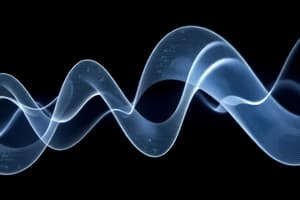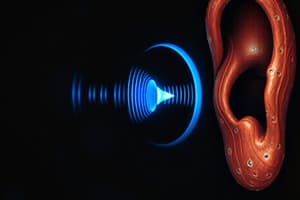Podcast
Questions and Answers
What unit is used to measure sound pressure levels?
What unit is used to measure sound pressure levels?
- Watts
- Decibels (correct)
- Amperes
- Hertz
Sound waves vary in sound pressure level and frequency.
Sound waves vary in sound pressure level and frequency.
True (A)
What is the branch of physics that studies sound?
What is the branch of physics that studies sound?
Acoustics
Digitizing is converting ______ signal to digital numbers.
Digitizing is converting ______ signal to digital numbers.
Match the sampling rates with their descriptions:
Match the sampling rates with their descriptions:
What are the two additional reasons mentioned in the content for working with digital audio?
What are the two additional reasons mentioned in the content for working with digital audio?
What does LPCM stand for in relation to audio file formats?
What does LPCM stand for in relation to audio file formats?
MP3 incorporates a 'lossless' compression algorithm to save space.
MP3 incorporates a 'lossless' compression algorithm to save space.
AAC is the default format for iPod, iPhone, PlayStation, Wii, DSi, and many mobile phones including ____, Nokia, Philips, Samsung, Siemens, and Sony Ericsson.
AAC is the default format for iPod, iPhone, PlayStation, Wii, DSi, and many mobile phones including ____, Nokia, Philips, Samsung, Siemens, and Sony Ericsson.
Flashcards are hidden until you start studying
Study Notes
Acoustics and Sound
- Acoustics is the branch of physics that studies sound
- Sound pressure levels (loudness or volume) are measured in decibels (dB)
- Sound waves vary in sound pressure level (amplitude) and in frequency or pitch
Digital Audio
- Digital audio is created by representing the characteristics of a sound wave using numbers
- Digitizing involves converting analog signals to digital numbers
- Digitized sound is sampled sound, with samples taken every nth fraction of a second
- The quality of digital recording depends on the sampling rate and bit depth
Sampling Rates and Bit Depth
- Common sampling rates include 44.1 kHz (CD-quality), 22.05 kHz, and 11.025 kHz
- Sample sizes are typically 8 bits or 16 bits
- Higher sampling rates and bit depths result in higher quality audio
Mono and Stereo
- Stereo recordings use two microphones (left and right) and require twice as much storage space as mono files
- Stereo recordings are more lifelike and realistic than mono recordings
Archiving Digital Audio
- Archiving audio at a higher specification than needed allows for potential future upgrades in playback technology
Editing Digital Recordings
- Basic sound-editing operations include:
- Trimming: removing dead air or unnecessary extra time from a recording
- Splicing and assembly: removing extraneous noises and assembling longer recordings
- Volume adjustments: adjusting the overall volume of a recording
- Format conversion: converting between different audio formats
- Resampling or downsampling: converting to a lower sampling rate or bit depth
- Fade-ins and fade-outs: smoothing out the beginning and end of a sound file
- Equalization: modifying the frequency content of a recording
- Time stretching: altering the length of a sound file without changing its pitch
- Digital signal processing (DSP): processing a signal with special effects
- Reversing sounds: playing a sound in reverse
- Multiple tracks: editing and combining multiple tracks
MIDI Audio
- MIDI (Musical Instrument Digital Interface) is a communications standard for electronic musical instruments and computers
- MIDI provides a protocol for passing detailed descriptions of a musical score
- MIDI data is not digitized sound, but a shorthand representation of music stored in numeric form
- Composing original scores can be done using MIDI
MIDI vs. Digital Audio
- MIDI advantages:
- Smaller file size
- Flexibility in editing and playback
- Device-independent playback quality
- MIDI disadvantages:
- Playback quality depends on the end user's MIDI device
- Limited use for spoken dialog
- Digital audio advantages:
- Wider selection of application software and system support
- No music theory knowledge required
- Digital audio disadvantages:
- Larger file size
- Limited editing flexibility
Audio File Formats
- Common audio file formats include:
- AIFF (Audio Interchange File Format)
- WAV (Waveform Audio File Format)
- MP3 (MPEG Audio Layer 3)
- AAC (Advanced Audio Coding)
- MP4 (MPEG-4 Part 14)
- Codecs (compressor-decompressor) software compress and decompress audio data for storage and transmission
Managing Audio Files and Integrating into Multimedia Projects
- Considerations include:
- File format compatibility
- Sound playback capabilities
- Sound type and placement in the project
- Acquiring and editing source material
- Testing sound-and-image synchronization
- Copyright and licensing issues
Studying That Suits You
Use AI to generate personalized quizzes and flashcards to suit your learning preferences.




